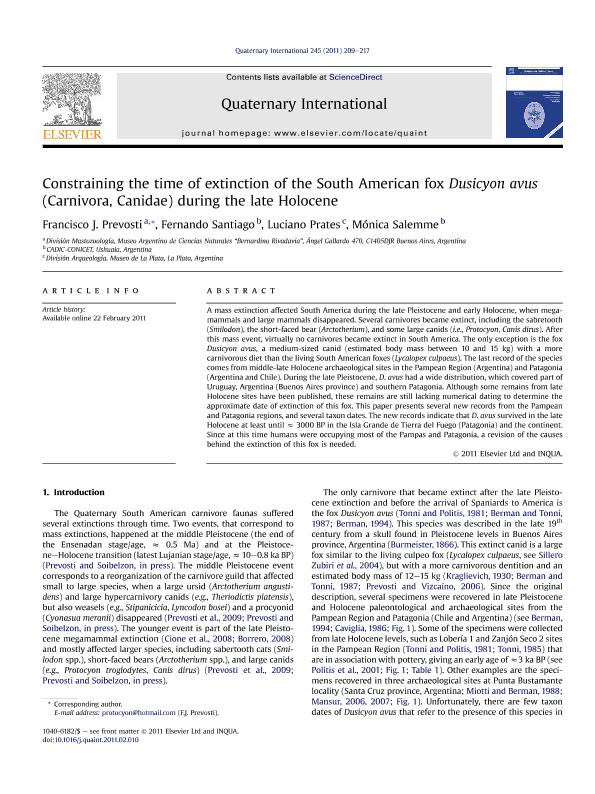Mostrar el registro sencillo del ítem
dc.contributor.author
Prevosti, Francisco Juan

dc.contributor.author
Santiago, Fernando Carlos

dc.contributor.author
Prates, Luciano Raúl

dc.contributor.author
Salemme, Monica Cira

dc.date.available
2017-02-21T14:19:34Z
dc.date.issued
2011-02-22
dc.identifier.citation
Prevosti, Francisco Juan; Santiago, Fernando Carlos; Prates, Luciano Raúl; Salemme, Monica Cira; Constraining the time of extinction of the South American fox Dusicyon avus (Carnivora, Canidae) during the late Holocene; Elsevier; Quaternary International; 245; 2; 22-2-2011; 209-217
dc.identifier.issn
1040-6182
dc.identifier.uri
http://hdl.handle.net/11336/13232
dc.description.abstract
The mass extinction at the end of the Pleistocene affected South America during the Late Pleistocene and the Early Holocene, when megamammals and large mammals disappeared. Several carnivores became extinct, like the sabretooth (Smilodon), the short face bear (Arctotherium) and some large canids (i.e. Protocyon, Canis dirus). After this mass event virtually no carnivores became extinct in South America. The only exception is the fox Dusicyon avus, a medium sized canid (estimated body mass between 10-15 kg) with a more carnivore diet than the living South American foxes (i.e. Lycalopex culpaeus). The last record of the species comes from middle-late Holocene archaeological sites in the Pampean Region (Argentina) and Patagonia (Argentina and Chile). During the Late Pleistocene D. avus had a wide distribution, which covered part of Uruguay, Argentina (Buenos Aires province) and the southern Patagonia. Albeit some remains from late Holocene sites have been published, these remains are still lacking absolute dating to determine the approximate date of extinction of this fox. In this contribution we present several new records from the Pampean and Patagonia regions, and several taxon dates. The new records indicate that D. avus survived in the late Holocene at least until ≈ 3000 radiocarbon years BP in the Isla Grande de Tierra del Fuego (Patagonia) and the continent. Since at this time humans were occupying most of the Pampas and Patagonia a revision of the causes behind the extinction of this fox is needed.
dc.format
application/pdf
dc.language.iso
eng
dc.publisher
Elsevier

dc.rights
info:eu-repo/semantics/openAccess
dc.rights.uri
https://creativecommons.org/licenses/by-nc-nd/2.5/ar/
dc.subject
Canids
dc.subject
Extinction
dc.subject
Late Holocene
dc.subject
Pampa-Patagonia
dc.subject.classification
Otras Historia y Arqueología

dc.subject.classification
Historia y Arqueología

dc.subject.classification
HUMANIDADES

dc.title
Constraining the time of extinction of the South American fox Dusicyon avus (Carnivora, Canidae) during the late Holocene
dc.type
info:eu-repo/semantics/article
dc.type
info:ar-repo/semantics/artículo
dc.type
info:eu-repo/semantics/publishedVersion
dc.date.updated
2017-02-07T18:01:54Z
dc.journal.volume
245
dc.journal.number
2
dc.journal.pagination
209-217
dc.journal.pais
Países Bajos

dc.journal.ciudad
Amsterdam
dc.description.fil
Fil: Prevosti, Francisco Juan. Consejo Nacional de Investigaciones Científicas y Técnicas. Oficina de Coordinación Administrativa Parque Centenario. Museo Argentino de Ciencias Naturales; Argentina
dc.description.fil
Fil: Santiago, Fernando Carlos. Consejo Nacional de Investigaciones Científicas y Técnicas. Centro Austral de Investigaciones Científicas; Argentina
dc.description.fil
Fil: Prates, Luciano Raúl. Universidad Nacional de la Plata. Facultad de Ciencias Naturales y Museo; Argentina. Consejo Nacional de Investigaciones Científicas y Técnicas; Argentina
dc.description.fil
Fil: Salemme, Monica Cira. Consejo Nacional de Investigaciones Científicas y Técnicas. Centro Austral de Investigaciones Científicas; Argentina
dc.journal.title
Quaternary International

dc.relation.alternativeid
info:eu-repo/semantics/altIdentifier/doi/http://dx.doi.org/10.1016/j.quaint.2011.02.010
dc.relation.alternativeid
info:eu-repo/semantics/altIdentifier/url/http://www.sciencedirect.com/science/article/pii/S1040618211000887
Archivos asociados
